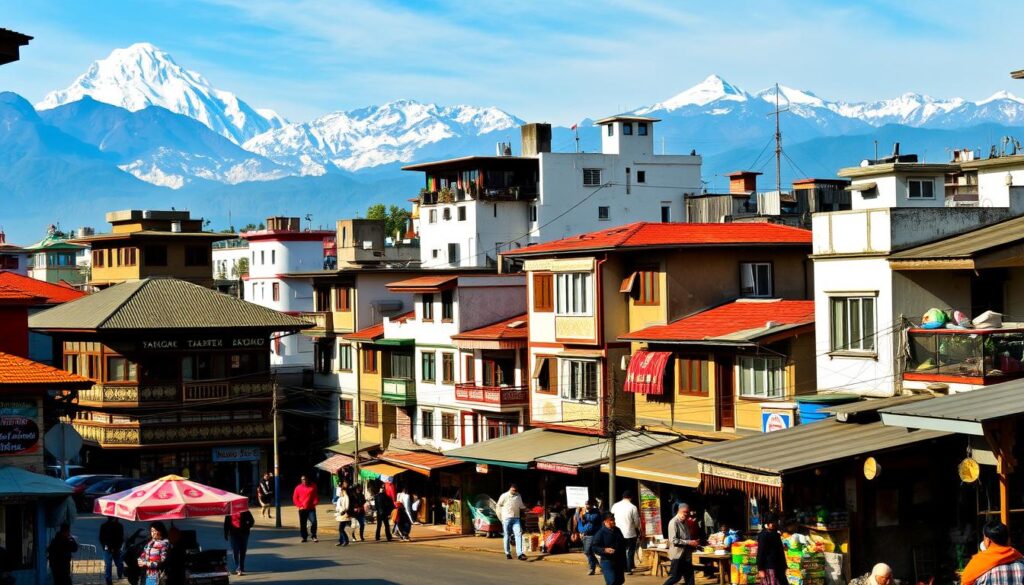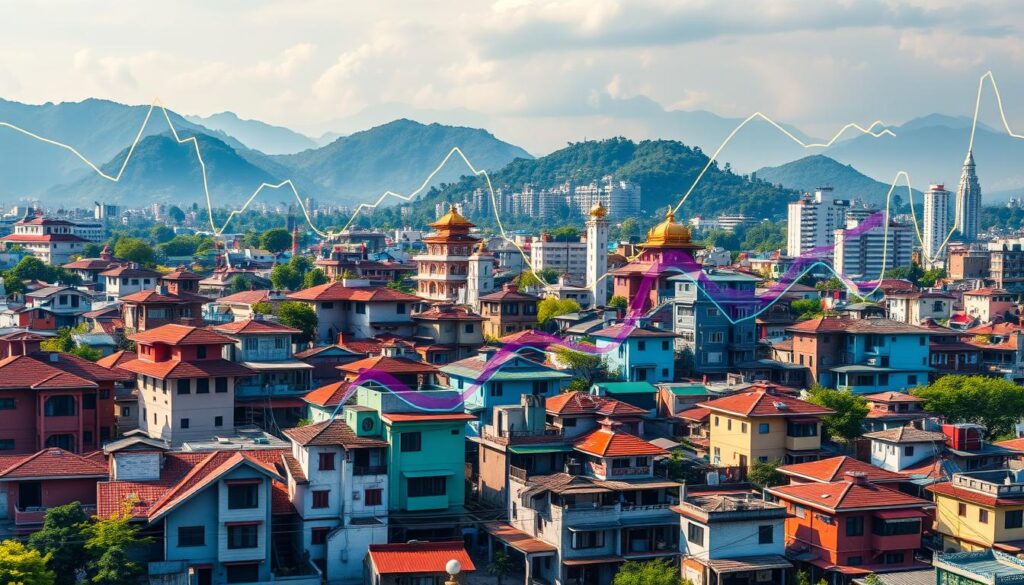The Nepal Housing Market is getting a lot of focus lately. This is due to average house prices per square meter showing the market’s changing nature. Cities are growing and the economy is expanding. This has made house prices in Nepal, especially in Kathmandu, jump higher. Kathmandu is now a hot spot for buying property and building homes. The current trends show house prices keep going up. Experts think this will keep happening due to population growth and economic reasons.
An average government worker in Nepal makes Rs36,000 a month. But to buy a two-bedroom apartment in Hatiban for Rs8.5 million1, they would need around 20 years of their salary. This fact underlines how important it is for home buyers to get advice from real estate experts in Nepal. They can help understand the costs of building a house, legal fees, and getting the necessary permits. This is crucial for a good grasp of the housing market. For more details, check this link for further insights.
Key Takeaways
- The average house price per square meter varies significantly between Kathmandu and other major cities.
- Urbanization influences the rapid appreciation of property values, with some areas seeing increases that double in just three to four years.
- Consulting construction professionals is crucial for accurate financial planning in the Nepal housing market.
- The affordability of homes continues to challenge many as prices soar amidst rising demand.
- Understanding financing options is key, particularly in light of recent banking trends toward real estate investments.
- Income ratios suggest that significant portions of salaries are needed to secure housing, highlighting financial pressures on buyers.
Contact us if you are Interested in Buying Property Abroad!
Overview of the Nepal Housing Market

The housing scene in Nepal is changing fast, thanks to city growth and economic improvements. There’s a big interest in places to live and work, spurred by big projects and government plans for affordable homes. These changes are moving us towards greener and smarter ways to live.
Current Trends and Developments
In just one month, 76,532 houses and plots were traded, bringing in Rs. 6.65 billion2. Places like Suryavinayak, Duwakot, and Godavari are hot spots for buyers because they’re easy to get to and growing fast2. With more people moving to cities, about 23% live in poor conditions. This has sparked action for better housing solutions3.
Key Factors Influencing the Market
Nepal’s housing market is impacted by its economic growth of 5.61% and a population rise of 0.74%. The property sector is a big chunk of Nepal’s economy, making up 8% of its GDP3. Plus, low interest rates on loans are making people keen to invest in property2.
After COVID-19, buying a house has become more competitive, driving prices up2. Rules and regulations also shape this market, focusing on clear rules and preventing risky buys. As we look closer at Nepal’s housing market, it’s clear that it’s ripe for more growth and investment.
Average House Prices by Region

In Kathmandu, house prices vary a lot depending on the area. This is something vital for potential buyers and investors to know. The average price per square meter shows us how much demand there is and how the location affects the price.
Price Breakdown in Kathmandu
In central Kathmandu, properties cost more, with an average of NPR 26,638.13 per square foot. On the edges of the city, it’s cheaper, at about NPR 14,717.28 per square foot. This big price difference tells us that people value living in the center for its convenience and city benefits. By looking closely at property prices in Nepal, we learn important things for anyone thinking about buying real estate in the area4.
Comparative Analysis with Other Major Cities
Looking beyond Kathmandu, we see cities like Pokhara and Lalitpur have lower house prices. These cities are becoming more attractive to buyers who want an affordable but lively urban setting. However, prices in these cities are starting to rise, showing a trend across Nepal. This steady increase reflects the changing nature of the Kathmandu housing market and its influence on other places4.
Contact us if you are Interested in Buying Property Abroad!
Nepal Housing Market: Affordability and Financial Statistics

Understanding Nepal’s housing market requires looking at key financial stats. The price to income ratio is 35.30%. This shows that people spend a lot of their income on housing. According to mortgage statistics in Nepal, the mortgage rate is 501.83% of income. This highlights the struggle for buyers in cities5.
Price to Income Ratio and Mortgage Statistics
Housing affordability in Nepal is a big issue. The average monthly salary is about NPR 31,521.79. This fact helps us think about the possibility of buying a home5. The Loan Affordability Index is at 0.20, making it hard to get home loans. Interest rates vary from 10.50% to 16.00% for a 20-year fixed-rate mortgage5.
Average Monthly Salary and Loan Affordability
The average salary in Nepal is crucial for understanding loan affordability in Nepal. Many families face difficulties with the high cost of properties. There’s a big demand for affordable housing. Economic pressures are a big challenge for buyers in Nepal’s housing market. The gap between income and house prices makes buying a home tough. It shows the need for good financial planning in Nepal’s changing real estate market.
Construction Costs and Housing Quality

It’s crucial for anyone looking to buy a house in Kathmandu to understand the construction costs. Various factors play a role in determining these expenses. They all influence the overall price of homes in the area.
Determinants of Building Costs in Kathmandu
Construction costs are affected by several key factors. These include the location, the building’s design, and the materials used. Land in urban areas like Kathmandu has prices that can make a big difference6. High land costs, demand for certain locations, and local amenities can all increase the price7.
Material and Labor Costs for Construction
Material costs are a big part of building expenses in Nepal. For instance, the foundation of a house might cost between NPR 1,000 and NPR 1,500 per square foot. Construction of the structure itself can range from NPR 1,500 to NPR 2,500 per square foot6. Labor adds 10-15% more to the total cost, and high-quality materials are needed for a durable home67.
Average Estimates for Different Types of Homes
A simple 1,000 square foot house in Kathmandu could cost around NPR 55,150,000. This price includes land and utilities6. The price for bigger, 2.5 or 3-story houses starts from NPR 7,500,000 and can go much higher based on construction quality78. These prices show how better infrastructure and amenities can raise the value of a property8.
Conclusion
The property prices in Nepal are going up, mainly because more people are moving to cities and other economic reasons. The market is expected to grow by 5.46% between 2025 and 2028. This will make its value rise to $0.47 trillion. This is good news for people looking to invest in this area9. But, it’s important to remember that not everyone can afford a house. Also, getting a loan for a house is still hard for many people10.
A big part of the real estate market is for building homes. This shows that as more people move to cities, they need places to live11. How well the housing market does is linked to things like new roads and airports being built. These improvements make people want to invest more in the market9.
It’s key to keep up with trends and numbers in the Nepalese real estate market to make smart choices. The future looks good, but there are still challenges to overcome. To make the most of this growing market, buyers and investors should be prepared. For more details, you can read insights on the Nepal Housing Market here10.
Contact us if you are Interested in Buying Property Abroad!
FAQ
What are the average house prices per square meter in Nepal?
House prices in Nepal vary by region. In the heart of Kathmandu, prices range from NPR 26,638.13 to NPR 14,717.28 per square foot in less busy areas.
How does urbanization affect the Nepal Housing Market?
Urbanization drives up the demand for homes and business spaces. This is especially true in big cities like Kathmandu as more people move there seeking better jobs.
What are the current trends in the Nepali real estate market?
The real estate market in Nepal is seeing more people wanting houses because of urban migration. There’s also a growth in infrastructure and a need for affordable homes. Plus, there’s an uptick in green and smart homes.
How do economic factors influence property prices in Nepal?
Things like GDP growth, population increase, and job rates affect property needs and prices. These factors are key to understanding Nepal’s housing market.
What is the Price to Income Ratio in Nepal?
The Price to Income Ratio is 35.30 in Nepal. This measures how housing prices relate to income, showing the affordability challenge for many, especially in cities.
What are the labor costs involved in construction in Kathmandu?
Construction labor costs vary. Basic projects cost between NPR 3,000 to NPR 3,500 per square foot. High-end work starts at NPR 6,000 per square foot.
How do property prices in Kathmandu compare to other major Nepali cities?
Kathmandu’s property prices top those in Pokhara and Lalitpur. These cities are more budget-friendly but their property prices are also increasing.
What challenges do potential homebuyers face regarding mortgage availability in Nepal?
Homebuyers with an average salary of NPR 31,521.79 face tough times getting loans. A low Loan Affordability Index of 0.20 and high-interest rates between 10.50% to 16.00% add to the challenge.
Are there any government initiatives to improve affordable housing in Nepal?
Yes, the government is focusing on more affordable housing. This is to meet the high demand and issues caused by people moving into cities.
Source Links
- https://nepalitimes.com/here-now/kathmandu-s-unreal-real-estate-prices
- https://www.realestateinnepal.com/present-scenario-of-real-estate-market-in-nepal/
- https://gtn.com.np/2021/02/current-scenario-of-real-estate-in-nepal/
- https://www.elibrary.imf.org/view/journals/002/2024/108/article-A004-en.xml
- https://www.ucl.ac.uk/dpu-projects/drivers_urb_change/urb_economy/pdf_infor_econo/ESFN_AERUS_Mathema-kathmandu.pdf
- https://www.expertsewa.com/blogs-details/How-Much-Does-Innovative-Home-Construction-Cost-in-Nepal
- https://karyabinayakhomes.com/factors-affecting-price-housing-nepal/
- https://www.realestateinnepal.com/factors-affect-house-price/
- https://abhravillas.com/invest-real-estate-nepal/
- https://gharsansarnepal.com/blog/real-estate-condition-in-nepal
- https://www.realestateinnepal.com/real-estate-good-investment-in-nepal/

Comments